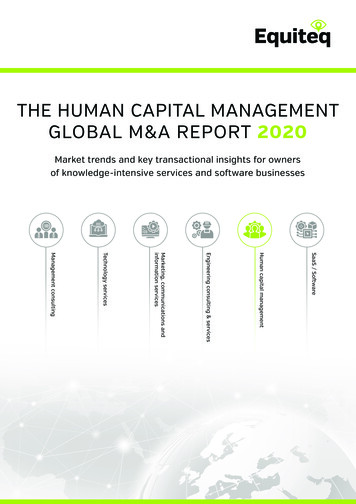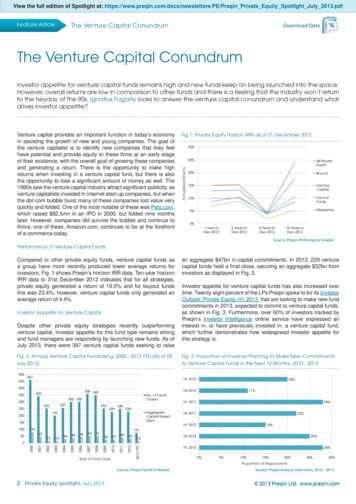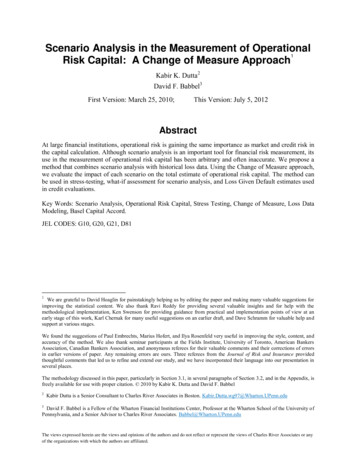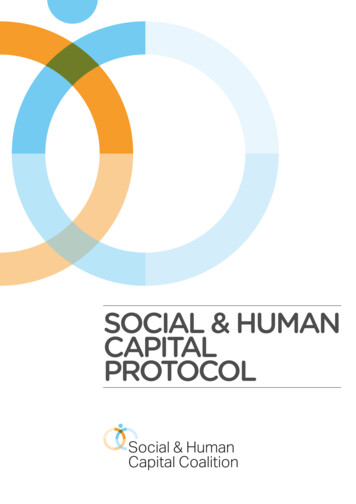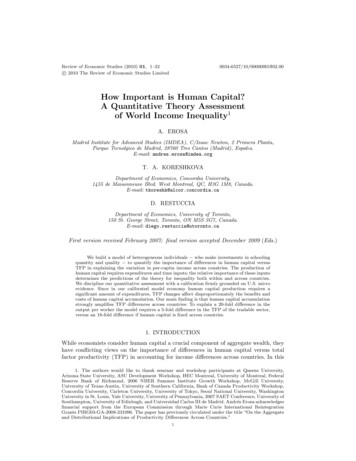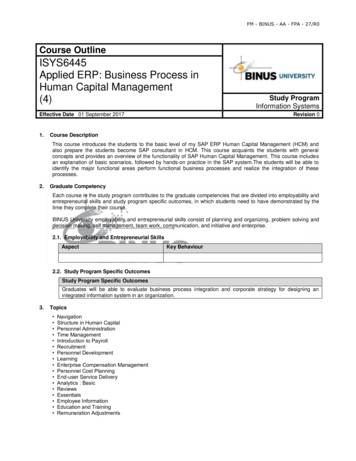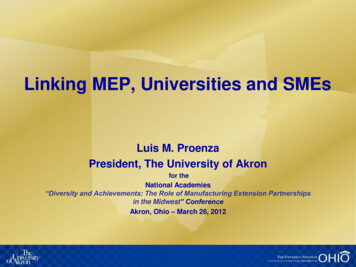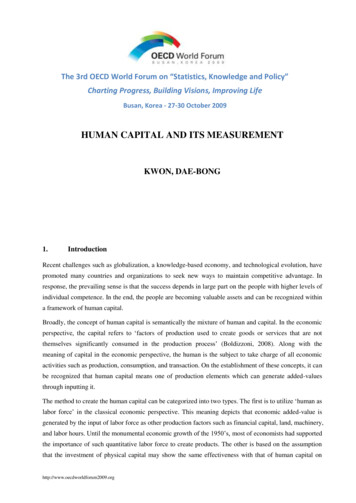
Transcription
The 3rd OECD World Forum on “Statistics, Knowledge and Policy”Charting Progress, Building Visions, Improving LifeBusan, Korea - 27-30 October 2009HUMAN CAPITAL AND ITS MEASUREMENTKWON, DAE-BONG1.IntroductionRecent challenges such as globalization, a knowledge-based economy, and technological evolution, havepromoted many countries and organizations to seek new ways to maintain competitive advantage. Inresponse, the prevailing sense is that the success depends in large part on the people with higher levels ofindividual competence. In the end, the people are becoming valuable assets and can be recognized withina framework of human capital.Broadly, the concept of human capital is semantically the mixture of human and capital. In the economicperspective, the capital refers to ‘factors of production used to create goods or services that are notthemselves significantly consumed in the production process’ (Boldizzoni, 2008). Along with themeaning of capital in the economic perspective, the human is the subject to take charge of all economicactivities such as production, consumption, and transaction. On the establishment of these concepts, it canbe recognized that human capital means one of production elements which can generate added-valuesthrough inputting it.The method to create the human capital can be categorized into two types. The first is to utilize ‘human aslabor force’ in the classical economic perspective. This meaning depicts that economic added-value isgenerated by the input of labor force as other production factors such as financial capital, land, machinery,and labor hours. Until the monumental economic growth of the 1950’s, most of economists had supportedthe importance of such quantitative labor force to create products. The other is based on the assumptionthat the investment of physical capital may show the same effectiveness with that of human capital onhttp://www.oecdworldforum2009.org
education and training (Little, 2003). Considering that the assumption accepts as a premise, the humancapital expansively includes the meaning of ‘human as creator’ who frames knowledge, skills,competency, and experience originated by continuously connecting between ‘self’ and ‘environment’.Among those concepts of the human capital, it tends to be recognized that the latter is more importantthan the former (Beach, 2009). Actually, many empirical literatures show that human capital affectsvarious social components. In the 1950’s, some economists discovered that the investment of humancapital was the primary element to raise individuals’ wages compared to the quantitative input of othercomponents such as land, financial capital, and labor force (Salamon, 1991). Similar to this, Woodhall(2001) presents that the investment of human capital is more effective than that of physical capital.Throughout the investment of human capital, an individual’s acquired knowledge and skills can easilytransfer to certain goods and services (Romer, 1990). Considering that accumulation of knowledge andskills takes charge of important role for that of human capital, there is a widespread belief that learning isthe core factor to increase the human capital. In other words, learning is an important component to obtainmuch knowledge and skills through lots of acquisition ways including relationship between the individualand the others (Sleezer, Conti, Nolan, 2003). Currently, it is acceptable that the conceptual foundation ofone’s human capital is based on ‘something like knowledge and skills’ acquired by an individual’slearning activities. Assuming that knowledge can broadly include other factors of human capital such asskills, experience, and competency, human capital and ‘knowledge as broad meaning’ is recognized assynonymous expression.Such accumulation of human capital through learning activities significantly influences many sectors. Inthe macroscopic aspects, many researchers present that accumulation of one’s human capital on educationand training investment largely affects the growth of an individual’ wage, firms’ productivity, andnational economy (Denison, 1962; Schultz, 1961). Microscopically, Lepak & Snell (1999) show thatfirm’s core competences or competitive advantage is induced by the investment of human capital entailedwith value creating potential.Human capital has being paid more attention in the workplace as well. According to Lucas (1988), amicroeconomic model shows that education investment for workers significantly affects his/herproductivity in the workplace. Along with the belief of education about improving workers’ productivity,many researchers stress the importance of education and training in the human capital field (Griliches &Regev, 1995; Rosen, 1999).Not only one’s productivity but others are affected by the investment of human capital. Throughparticipating in leaning activity, the learning participators are likely to easily implement job-seekingactivities with increasing the human capital (Vinokur et al., 2000). After being employed, the workerstend to easily control their working condition in the workplace and relatively receive high rewards in theinternal/external labor market (Edward, 1979). Furthermore, the investment of human capital affectsnational economic growth on the above-mentioned impacts as well (Romer, 1986).Page 2 of 15
With perceiving about the importance of human capital, many countries have tried to effectively andefficiently measure their human capital to understand their current status and thereafter implementedvarious ways to improve their human capital. Therefore, it can be recognized that human capitalmeasurement is an important source in terms of suggesting various policies regarding human resources.Despite this necessity of human capital measurement, traditional method of the human capitalmeasurement includes a few limitations. To begin with, Wolf (2002) suggests that some of indicators canbe actually considered as incomplete ones. To support his assertion, he exemplifies that a worker’s wageone of human capital indicators as proxies-hardly measures ‘authentic human capital’. By the drawbackof traditional human capital measurement, it is acceptable to measure the authentic human capital insteadof utilizing proxies such as income and productivity.Second, it is difficult that human capital itself independently contributes to individual development andnational economy growth. According to Ashton & Green (1996), it is necessary that the link betweenhuman capital and economic performance should be considered within a social and political context toprecisely measure the human capital. Furthermore, many empirical literatures present that financial,human and social capital positively influence ‘something like individual health’ (Blakey, Lochner, &Kawachi, 2002; Veenstra, 2001; Veenstra et al., 2005; Wilson et al., 2004).Consequently, the purpose of this study is to clarify a new approach of human capital measurementthrough the related literature review. Before doing this, this paper presents some concepts andcharacteristics of human capital. On such understanding of human capital, traditional human capitalmeasurement and its demerit, a new approach of human capital measurement is proposed.2.Concept of Human CapitalThe origin of human capital goes back to the emergence of classical economics in 1776, and thereafterdeveloped a scientific theory (Fitzsimons, 1999). After the manifestation of that concept as a theory,Schultz (1961) recognized the human capital as one of important factors for a national economic growthin the modern economy. With the emergence and development of human capital as an academic field,some researchers expansively attempted to clarify how the human capital could contribute to sociopolitical development and freedom (Alexander, 1996; Grubb & Lazerson, 2004; Sen, 1999).The concept of human capital can be variously categorized by each perspective of academic fields. Thefirst viewpoint is based on the individual aspects. Schultz (1961) recognized the human capital as‘something akin to property’ against the concept of labor force in the classical perspective, andconceptualized ‘the productive capacity of human beings in now vastly larger than all other forms ofwealth taken together’. Most of researchers have accepted that his thought viewing the capacity of humanbeing is knowledge and skills embedded in an individual (Beach, 2009). Similar to his thought, a fewresearchers show that the human capital can be closely linked to knowledge, skills, education, andPage 3 of 15
abilities (Garavan et al., 2001; Youndt et al., 2004). Rastogi (2002) conceptualizes the human capital as‘knowledge, competency, attitude and behavior embedded in an individual’.There is the second viewpoint on human capital itself and the accumulation process of it. This perspectivestresses on knowledge and skills obtained throughout educational activities such as compulsory education,postsecondary education, and vocational education (De la Fuente & Ciccone, 2002, as cited in Alan at al.,2008). Despite the extension of that concept, this perspective neglects that human being would acquireknowledge and skills throughout his/her own experience.The third is closely linked to the production-oriented perspective of human capital. Romer (1990) refersto the human capital as ‘a fundamental source of economic productivity’. Rosen (1999) states the humancapital as ‘an investment that people make in themselves to increase their productivity’. More recently,Frank & Bemanke (2007) define that human capital is ‘an amalgam of factors such as education,experience, training, intelligence, energy, work habits, trustworthiness, and initiative that affect the valueof a worker's marginal product’. Considering the production-oriented perspective, the human capital is‘the stock of skills and knowledge embodied in the ability to perform labor so as to produce economicvalue’ (Sheffin, 2003). Furthermore, some researchers define that human capital is ‘the knowledge, skills,competencies and attributes in individuals that facilitate the creation of personal, social and economicwell-being’ with the social perspective (Rodriguez & Loomis, 2007).Consequently, human capital simultaneously includes both of the instrumental concept to produce certainvalues and the ‘endogenous’ meaning to self-generate it. In order to dependently/independently createthese values, there is no doubt that leaning through education and training can be an important in terms ofdefining the concept of human capital. Considering that experience can be included as a category ofknowledge, the human capital is a synonym of knowledge embedded in individuals.3.Characteristic of Human capital3.1. Indigenous CharacteristicsAccording to Crawford (1991), compared to physical labor, human capital as broad meaning includesexpandable, self-generating, transportable, and shareable characteristic. To begin with, the expandableand self-generating characteristics of human capital are closely linked to the possibility that the stock ofknowledge increases individuals’ human capital. Furthermore, the increase of human capital can beexpanded by either endogenous or exogenous factors. It is possible that original knowledge can becontinuously elaborated and developed through the relationship between external knowledge, information,skills, experiences, and other knowledge-based factors as well. In the economic perspective, thecharacteristic of human capital focusing on knowledge can be a core element to solve ‘problem ofscarcity’ which little materials is equivalently distributed to economic agents. Throughout expanding andself-generating the human capital, it is sufficiently possible that the portion of that capital as an economicagent is extended.Page 4 of 15
Secondly, the transportable and shareable characteristics of human capital mean that the originalholder of knowledge can distribute his/her knowledge to others. On the circumstance that the originalknowledge-holder’s exclusive ownership is slightly acceptable, the equivalent distribution between theholders and the takers can be actualized. Consequently, the former two characteristics extend the‘volume’ of human capital, and the latter two expand the ‘range’ of human capital.3.2. Impacts of Human CapitalThe impact of human capital is largely categorized into three parts: individual, organization, and society.In the perspective of individual in the internal labor market, most of researchers refer to the possibility ofincreasing individual income, resulting from the individual productivity (Becker, 1993; Denison, 1962;Schultz, 1961; Schultz, 1971; Sidorkin, 2007). Because of the increment of an individual’s productivityon human capital, for the purpose of maximizing organizational profits, most of employers prefer to highproductive individuals. Furthermore, it is considerable that individual mobility increases owing to theimprovement of productivity in the internal labor market. By the increase of productivity in the workplace,the high-productive individual is recognized as the worker with much possibility to move to higher levelin the internal market (Sicherman, 1991; Galor 1990).In the perspective of individual in the external market, an unemployed individual’s human capital affectshis/her job-seeking and employable opportunities (Greider, Denise-Neinhaus, & Statham, 1992; Vinokuret al., 2000). On the internalized human capital, an individual easily holds the possibility to access jobrelated information with high level of human capital, and thereafter he/she can easily obtain theoccupational chances compared to otherwise.With respect to organization, Lepak & Snell (1999) suggest that the potential of human capital is closelylinked to core competences and competitiveness of organization. Similar to this perspective, Edvison &Malone (1997) present individual human capital can affect organizational human capital such as‘collective competences, organizational routines, company culture and relational capital’ as well.Finally, the social perspective of human capital is the synthesis of both individual and organizationalperspective. McMahon (1999) depicts the possibility of human capital for ‘democracy, human rights, andpolitical stability’ on common consciousness of social constituents. According to Beach (2009), humancapital can increase social consciousness of constituents within community. Consequently, the linkbetween human capital and social consciousness is based on a close inter-relationship resulting in sociopolitical development (Alexander, 1996; Grubb & Lazerson, 2004; Sen, 1999).3.3. Division of Human CapitalGenerally, some researchers present three distinguished kinds of human capital such as general, firmspecific, and task-specific human capital (Gibbons & Waldman, 2004; Hatch & Dyer, 2004). Otherwise,Becker (1964) delineates that human capital is categorized into general and specific one. General humancapital is ‘to be defined by generic knowledge and skill, not specific to a task or a company, usuallyPage 5 of 15
accumulated through working experiences and education’ (Alan at al., 2008). The general human capitalholds ‘transferable’ characteristic across jobs, firms and industry. It is relatively easy that the generalhuman capital embedded in an individual transfers to different industries.Contrast to the general human capital, firm/task specific human capital is usually accumulated througheducation, training, working experience on ‘knowledge specific to a firm/task’ (Alan at al., 2008). Aspointed out by Becker (1964, 1976), the specific human capital is rarely transferable to be applied to otherjobs, firm, and industry, and thus it is impossible to transfer much income in the labor market.Furthermore, human capital is ‘specific if it increases a worker’s productivity only at the firm’ (Becker,1964). Consequently, it is difficult that the specific human capital embedded in an individual transfers todifferent industries.4.Conventional Measurement Method of Human CapitalThe conventional standard to measure human capital stock has been largely categorized into three parts:Output-, Cost-, and Income-based approach. School enrollment rates, scholastic attainments, adultliteracy, and average years of schooling are the examples of output-based approach; cost-based approachis based on calculating costs paid for obtaining knowledge; and income-based approach is closely linkedto each individual’s benefits obtained by education and training investment.4.1. Output-Based ApproachFor the purpose of analyzing relationship between human capital and economic growth, some economistsattempted to measure the stock of human capital utilizing ‘school enrollment rates’ as a proxy of humancapital (Barro, 1991; Barro & Lee, 1993). Throughout calculating the ratio between individuals of schoolage and students enrolling in the educational institutions, the economists show the stock of human capitalthat each country holds. However, the method includes a drawback that a student’s effectiveness can berecognized after participating in production activities.In the perspective of educational attainment, Nehru, Swanson, & Dubey (1993) attempted to measurerelationship between human capital and students’ ‘accumulated years of schooling’ in the employable ageas educational attainment. Assuming that the stock of human capital is the sum of each individual’s yearsof schooling; it is difficult to clearly demonstrate this relationship, because educational attainment is apart of regular [school] education. Actually, many of adults tend to participate in many formal educationand training activities to improve their productivity.Besides measuring the stock of human capital with school enrollment rates and educational attainment,Romer (1990) suggested the ratio between skilled-adults and total adults to measure the stock of humancapital in the national economy. Furthermore, Organization for Economic Cooperation and Development(OECD) utilizes International Adult Literacy Survey (IALS), the ratio between literate adults and totaladults, to measure the stock of human capital. However, the method of IALS includes a few drawbacks inPage 6 of 15
that literacy can be slightly related to labor productivity, and the productivity can be increased byinformal/non-formal learning activities such as personal learning and On-the-Job trainingFinally, Psacharopoulos & Arriagada (1986) suggested the average years of schooling to measure thestock of human capital. They refer that the average years of schooling is meaningful to measure the stockof human capital as a proxy. This suggestion assumes that an individual’s productivity is increased inproportion to his/her average years of schooling; they exemplify that someone’s productivity withcompleting twelve years of schooling is twelve times compared to otherwise productivity with doing oneyears. As mentioned above, this method includes a drawback that an individual’s years of schooling canbe slightly related to his/her productivity.4.2. Cost-Based ApproachCost-based approach is based on measuring the stock of human capital through summing costs investedfor one’s human capital. For the purpose of calculating the invested costs, Kendric (1976) utilized anindividual’s investment costs considering depreciation, and Jorgenson & Fraumeni (1989) presenteddiscounted income in the future. Considering that this approach is based on indirectly measuring stock ofhuman capital, it is difficult to precisely classify boundary between investment and consumption in theperspective of costs for the human capital.4.3. Income-Based ApproachThis approach is based on the returns which an individual obtains from a labor market throughouteducation investment. Mulligan & Sala-i-Martin (1995) defines that aggregate human capital is the sumof quality adjustment of each individual’s labor force, and presents the stock of human capital utilizing anindividual’s income. Considering that ‘human-unrelated factors’ can more influence an individual’sincome, this approach rarely presents a complete measurement for human capital.4.4. How is Currently Human Capital Measured? : Based on OECD MeasuresHansson (2008) shows that OECD measurement on human capital is closely linked to internationalcomparable statistics considering investment in human capital, quality adjustments, and result ofeducation. On the constitution of human capital measurement, Table 1 presents how the constitution isdivided into sub-factors in detail. The first sub-factor is ‘investment in human capital’ focused on thecurrent level of human capital investment within a national boundary, and the second focuses on how thequality of that investment is managed and adjusted through the international comparison of academicachievement. Finally, third sub-factor presents how the result of educational investment is preformed afterpostsecondary education.Table 1. OECD measures on human capitalFactorsPage 7 of 15
Factors1. Investment in human capital1-1. High-level qualification1-1-1. Growth in university-level qualificationsGrowth in attainment levels in different fields1-2. Graduation and enrollment rates1-2-1. Trend in university-level graduation output1-2-2. Contribution of international students to university graduate output1-2-3. Entry rates into tertiary-type A education1-2-4. Entry rates at tertiary education compared to population leaving without completing tertiaryeducation1-3. Time invested in education1-3-1. Instruction time per year1-3-2. Number of hours per week spent on self-study or homework1-4. Investment in education1-4-1. Expenditure per student at different level of education1-4-2. Percentage of GDP spent on educational institutions1-4-3. Private and public expenditure1-4-4. Public subsidies for education to households1-4-5. Expenditure on core service, ancillary services, and R&D1-4-6. Change in student numbers, expenditure, demographic forecasts, etc2. Quality adjustment in human capital investments2-1. PISA assessments2-2. PUIAAC (Program for the international assessment of adult competencies)3. Results of education3-1. Matching of education to occupation3-2. Labor market outcomes by age, gender, and educational attainment3-3. Rates of return to educationPage 8 of 15
5.Demerits of the Conventional Measurement and New Possibilities5.1. Demerits of the Conventional MeasurementAccording to Winkler (1987), the conceptual critique of human capital measurement is closely linked toscreening theory which expresses relationship between an individual’s credentials and employability.This critique addresses the unclear causality whether education credentials reflect the productivity. On thecriticism that an individual’s human capital increases his/her employability, Winkler (1987) surmises thathuman capital investment rarely influence his/her outcome of it. Rather, the capital-unrelated factors moreaffect the effectiveness of human capital investment. In this sense, it is necessary to seriously considerwhich one can clearly express the concept of human capital.Second, the conventional measurement of human capital slightly considers the qualitative benefits ofhuman capital such as family health, fertility and child morality (Lewin et al., 1983; Woodhall, 2001).Actually, McMahon (1998) presents that the impact of human capital includes both of financial monetaryand social nonmonetary benefits with ‘lower fertility rates, lower population rates, public health,democratization, human rights, political stability, poverty reduction, property crime rates, environmentaleffects, higher divorce rates, later retirement, more work after retirement, and community service’.Third, other indicators that can contribute to estimate more accurate concept of human capital are rarelyconsidered. For example, Bassani (2008) shows that social capital can be related to human capital to someextent. Similar to the mentioned conceptual framework, Coleman (1988) suggested that ‘certain aspectsof social capital could be directly linked to a child’s academic success in that they provided a moresupportive environment that enhanced individual levels of achievement’. Overall, for the purpose of moreprecise measurement of human capital as stock, it is necessary to consider relationship between humancapital and other related factors such as social capital.Fourth, the increase of human capital can rarely ensure that of social progress. Schuller (2001) refers to‘merely increasing the stock of human capital in any given society will not ensure social or economicprogress’. On the reference about the limitation of human capital, the conventional measurement ofhuman capital can slightly measure the extent of social progress. Considering that human capital shouldcontribute to constituents’ development in the normative perspective, it is essential that new additionalapproach of human capital measurement deliberates the aspects of social progress.5.2. New Approach of the MeasurementOn the above-mentioned demerits of conventional human capital measurement, new additional approachof the human capital measurement should be based on the following consideration; what are more preciseproxies for human capital measurement with the evolving of the human capital?To begin with, the new approach of human capital measurement partially needs to accept the conceptualframework of Human Development. Since 1990, United Nations Development Programme (UNDP) hasPage 9 of 15
reported Human Development Index (HDI) investigating most of countries, measuring a country’s humandevelopment and well-being (http://hdr.undp.org/en/statistics/indices/hid). The structure of the index isconstituted to health, knowledge, and standard living with many sub-variables such as life expectancy atbirth, adult literacy rate, gross enrollment ratio, and GDP per capita. Considering that the HDI indexincludes quality aspects, the approach of HDI focuses on all of individuals’ life quality and economicsituation. Furthermore, International Labour Office (ILO) tends to utilize the similar index consideringthe quality aspects such as the Key Indicators of the Labour Market (KILM).Therefore, it is necessary that the advanced measurement of human capital considers the concept of‘human development’, assuming that the concept of development includes both of quantitative growthand qualitative progress. With referring to the concept of human development, it is necessary that the newapproach of human capital measurement needs to pay more attention to social capital. As mentioned, anindividual’s social capital is closely linked to his/her human capital focused on the stock of knowledge.Considering that the core of the social capital is based on the networking among constituents, it ispossible that the networking component of social capital contributes to the increase of human capitalowing to the characteristics of that: transportable, and shareable. The accumulation of one’s humancapital is easily performed through social capital. Actually, someone’s level of knowledge and skills canbe more improved by the networking of family, colleagues, social and constituents rather than isolatedsituation (Coleman, 1988). This assumption can provide an important clue in terms of understanding howhuman capital can play a role in social progress.Finally, it is necessary that the new approach of human capital measurement clarifies what indicators canbe considered to precisely measure more accurate human capital. It is likely that the conventionalmeasurement of human capital utilizes proxies such as an individual’s productivity. OECD presents thatthe measurement on human capital is closely linked to education-related factors such as high-levelqualification, graduation and enrollment rates, time invested in education, and investment in education inthe perspective of the human capital investment as well (Hansson, 2008). However, these proxies have todo with the possibility that human capital takes place. A new approach need to seek indicators that aremore strongly related with the possibility and identify how to measure them.6.Policy ImplicationsBased upon the related literature review, some implications for both public decision makers andpractitioners who are interested in human capital and its measurement can be discussed as follow:First, there is no doubt that human capital is difficult to identify and measure directly. So manyresearchers have used to indirect measures. As such, more accurate measurement of human capital can beaccompanied with more plausible indicators as proxies. Furthermore, the concept of human capital needsto be expanded toward ‘human development’ with one’s wellbeing on health, knowledge, and standardliving. Because the conventional measurement of human capital focuses on the monetary perspective ofPage 10 of 15
human capital, it neglects the importance of its non-monetary aspects such as creativity, motivation,social networks etc. Today’s key feature is to emphasize the ‘humanware’ approach, such as reinforcingthe role of knowledge creator and human relationship creator to improve overall productivity, as opposedto the ‘software/hardware’, which would rather focus on downsizing, restructuring, and knowledge taker.As mentioned, the non-monetary characteristic of human capital includes the possibility of creatingadded-values, and thus the new approach of human capital needs to consider both of monetary and nonmonetary characteristic.Second, it is necessary to seriously consider how the broaden concept of human capital should bemeasured on all of monetary and non-monetary characteristic of human capital. Human capital is closelylinked to social capital. As mentioned, the core of social capital is the networking among constituents.The degree of one’s knowledge creation and sharing depends on the variety of networks focusing on tiedensity, frequency, strength and so on.
human capital and economic performance should be considered within a social and political context to precisely measure the human capital. Furthermore, many empirical literatures present that financial, human and social capital positively influence 'something like individual health' (Blakey, Lochner, & Kawachi, 2002; Veenstra, 2001; Veenstra .
